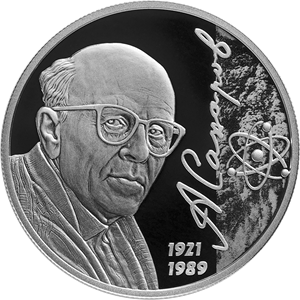Academician Andrey Sakharov, Timed to the 100th Anniversary of his Birth (21.05.1921)
Obverse
the mirror field of the disc bears a relief image of the National Coat of Arms of the Russian Federation, over it along the rim there is the semicircular inscription ‘РОССИЙСКАЯ ФЕДЕРАЦИЯ’ (RUSSIAN FEDERATION) framed on both sides by doubled rhombuses, below under the coat of arms there are indications of the precious metal and its fineness on the left and the fine metal content and the mint trade mark on the right, at the bottom in the centre, in three lines, there is an inscription ‘БАНК РОССИИ’ (BANK OF RUSSIA), the denomination of the coin ‘2 РУБЛЯ’ (2 RUBLES), and the year of issue ‘2021 г.’ (2021).
Reverse
the mirror field of the disc features a relief image of A. Sakharov’s portrait, a relief image of the atom diagramme on the right against a stylised background and, between these two images, a facsimile of the academician’s signature, vertically aligned, and his life years – ‘1921’ and ‘1989’ in two lines.
Authors
Designers: E.V. Kramskaya (obverse, reverse), A.V. Baklanov, National Artist of Russia (reverse).
Sculptors: A.A. Dolgopolova (obverse), A.N. Bessonov (reverse).
Mint: Saint Petersburg Mint (СПМД).
Edge: 195 corrugations.
Discover more
Andrei Sakharov (1921–1989) was a Russian physicist, member of the Soviet Academy of Sciences, public figure, and human rights activist.
In 1942, he graduated from the Physics Department of Moscow State University with an honours degree in defence extractive metallurgy. In 1945, he entered the Physical Institute of the Soviet Academy of Sciences (FIAN) to study for his Ph. D. Three years later, a special-purpose research group was established in FIAN to verify the calculations related to the development of a hydrogen bomb. Andrei Sakharov joined that group. The project was initially based on information received from foreign scientists. However, Sakharov proposed a fundamentally new design for a thermonuclear charge. The first test of a hydrogen bomb took place on 12 August 1953. That October, Sakharov was unanimously elected a member of the Academy of Sciences.
An ‘improved’ hydrogen bomb, developed by the same group, was tested in 1955. By that time, Sakharov had already started to think about humanitarian consequences of nuclear tests.
He published his first article on radioactive consequences of thermonuclear blasts in 1958, calling to stop the tests. In 1963, the USSR, the UK, and the USA signed the Partial Test Ban Treaty.
Since the 1960s, Sakharov became deeply involved in public activities. He spoke against the new law that allowed for ‘a larger-scale persecution for beliefs and information activity’. As a member of the Baikal Committee, he fought to ban industrial activity on the lake shore. In 1968, he wrote an essay ‘Reflections on Progress, Peaceful Coexistence, and Intellectual Freedom’. Since 1970, he was a member of the Committee on Human Rights.
Andrei Sakharov was awarded the Nobel Peace Prize in 1975.
Source: https://www.culture.ru


